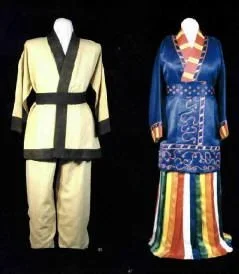reeskm
Green Belt
Agreed ShotoNoob, it's interesting to think about the origins. Without a doubt Hwang Kee was influenced by dojo precepts (a.k.a. dojo kun or dojang hun) used in Japan and Okinawa by all the famous Japanese style founders such as Mabuni, Miyagi, Toyama and Funakoshi.
Hwang Kee wrote many lists and precepts down, and the origins to them are varied and some not widely known. 5 of the 10 Articles of Faith come from the Korean monk Won Gwang and were given to the Hwarang as advice in how to conduct themselves. It is the same as the "Code of the Hwarang". Hwa Rang Do also uses the same code, naturally, as they style themselves 21st century Hwarang.
I've seen #8 also as "Kill with Justice and with Honour" and agree with the earlier comment that it was modified in the 70's for commercial schools because parent's might complain about their kids being taught to kill for great justice! I would add that it was also changed in Moo Duk Kwan Taekwondo or tournament schools where this rule does not transfer over well to point matches.
Don't confuse the 10 Articles of Faith on Mental Training with the 8 Key Concepts.
There is also Hwang Kee's 5 Moo Do Values (Moo Do for the Japanese stylists is Bu Do - Martial Way).
5 Moo Do Values:
1. Lyok Sa (History)
2. Jong Tong (Tradition)
3. Ki Kahng and Chan Kyong (Discipline and Respect)
4. Chul Hak (Philosophy)
5. Ki Sool (Technique)
Again, for reference the 8 key concepts are:
1. Yong Gi (Courage)
2. Chung Shin Tong Il (Concentration)
3. In Neh (Endurance)
4. Chung Jik (Honesty)
5. Kyum Son (Humility)
6. Him Cho Chung (Control of Power)
7. Shin Chook (Tension and Relaxation)
8. Wan Gup (Speed Control)
I'm currently researching these origins. I put it on my back burner but this thread is useful! If you have any insights share away
Hwang Kee wrote many lists and precepts down, and the origins to them are varied and some not widely known. 5 of the 10 Articles of Faith come from the Korean monk Won Gwang and were given to the Hwarang as advice in how to conduct themselves. It is the same as the "Code of the Hwarang". Hwa Rang Do also uses the same code, naturally, as they style themselves 21st century Hwarang.
I've seen #8 also as "Kill with Justice and with Honour" and agree with the earlier comment that it was modified in the 70's for commercial schools because parent's might complain about their kids being taught to kill for great justice! I would add that it was also changed in Moo Duk Kwan Taekwondo or tournament schools where this rule does not transfer over well to point matches.
Don't confuse the 10 Articles of Faith on Mental Training with the 8 Key Concepts.
There is also Hwang Kee's 5 Moo Do Values (Moo Do for the Japanese stylists is Bu Do - Martial Way).
5 Moo Do Values:
1. Lyok Sa (History)
2. Jong Tong (Tradition)
3. Ki Kahng and Chan Kyong (Discipline and Respect)
4. Chul Hak (Philosophy)
5. Ki Sool (Technique)
Again, for reference the 8 key concepts are:
1. Yong Gi (Courage)
2. Chung Shin Tong Il (Concentration)
3. In Neh (Endurance)
4. Chung Jik (Honesty)
5. Kyum Son (Humility)
6. Him Cho Chung (Control of Power)
7. Shin Chook (Tension and Relaxation)
8. Wan Gup (Speed Control)
I'm currently researching these origins. I put it on my back burner but this thread is useful! If you have any insights share away

